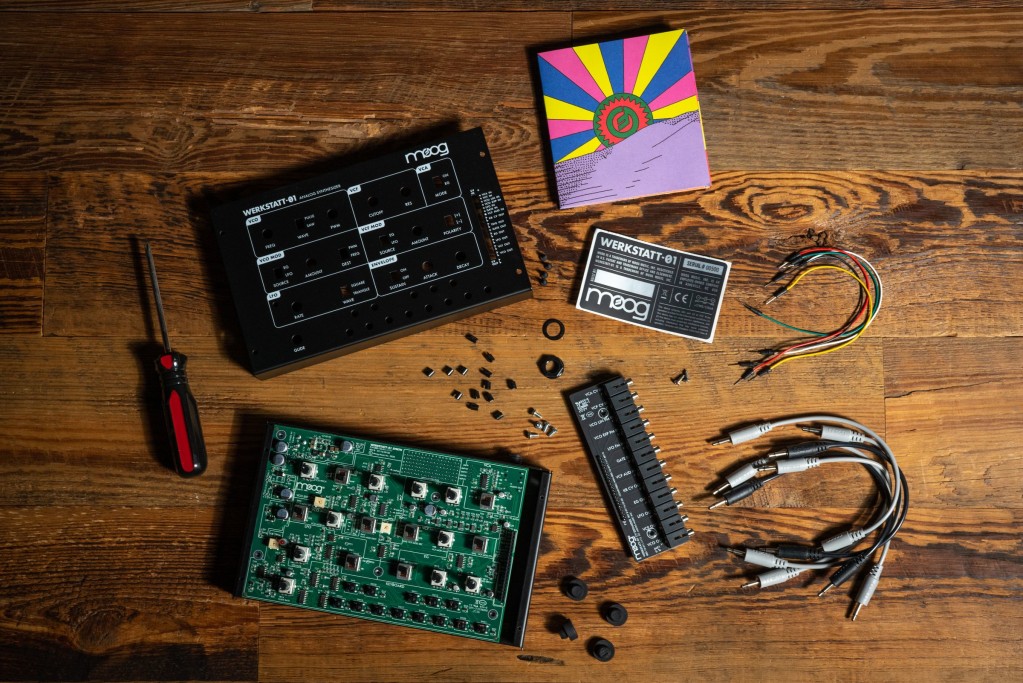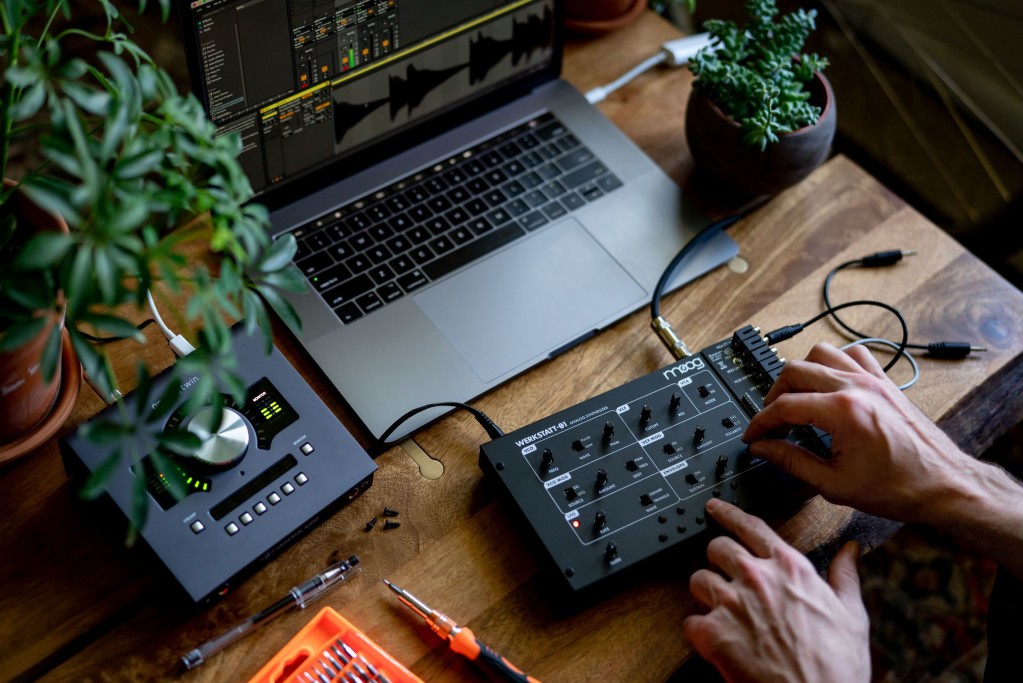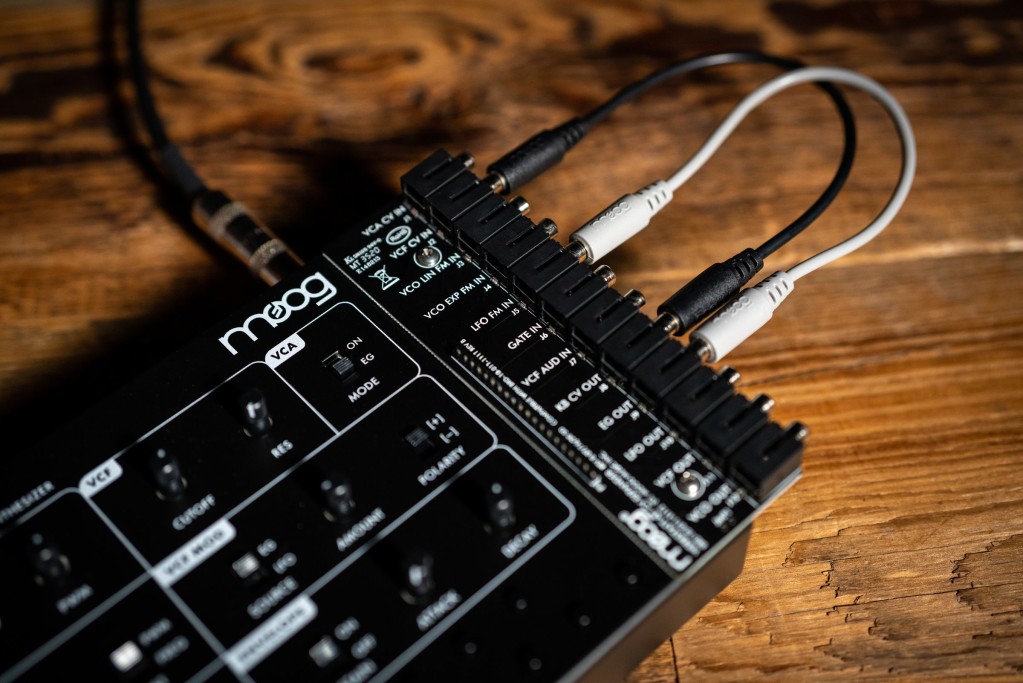We may be unable to go anywhere this year, but the Moog synth class is coming to us. Moog’s Werkstatt-01 analog synth kit packs a ton of analog sound capabilities into a $199 package.
The Werkstatt-01 debuted back in 2014. But first, you had to go to Moogfest to a workshop to get it. Then, you could get it in limited quantities for just over $300.
Now, Werkstatt-01 is back for another limited run, but costs just US$199, and throws in a 1/8″ (3.5mm) CV Expander in the box, too. That CV Expander means you can patch it together with other analog gear – not only Eurorack, but also Moog’s semi-modular and patchable instruments, and stuff from many other makers. (Combining the Werkstatt with the KORG volca modular, for instance, would be an insanely affordable and tiny yet remarkably complete “East Coast / West Coast” synthesis rig! For the West Coast side of that, read the exhaustive review Francis Preve did for CDM.)
The Werkstatt-01 is something special. You get a reasonably easy-build, no-solder kit, and then you’ve got an authentic Moog voice with enough features to do a range of sound design and instrumentation, bass to percussion to … whatever. From the beginning, everyone I know who’s touched this thing raves about how good it sounds.
And holy crap, it does sound amazing. Here’s a Moog-produced track with eight of them – though you could of course use one and overdub/sample:


Specs:
- 100% analog signal path
- An octave of buttons for quick key control
- Monophonic synth voice – saw and variable pulse waves, 8 Hz (LFO range!) – 16 KHz
- Oscillator has both linear and exponential frequency modulation inputs (yeah, like the kind of modulation options we just spoke about on the Matriarch!)
- Envelope source – sustain, attack, decay
- Ladder filter with resonance (hey, it’s a Moog)
- Set amplitude to envelope source
- Modulate filter with envelope, with adjustable polarity and amount
- Dedicated LFO, with square/triangle waves and rate. LFO runs 2 Hz – 600 Hz, so it’s usable for FM.
- Patchable via jumper cables (on the unit), or 3.5mm minijacks ((via the CV expander), both included
There are a lot more details in there, too – see the manual. This really is like a baby Moog modular for two hundred bucks!
Even before you add in the power of that CV expansion, you can do a lot with modulation onboard – adjusting oscillator modulation and filter modulation. And it’s a natural voice and modulation source to use with other gear. In fact, it means you have a lot of the power of a modular system even if all you own is one or two inexpensive, compact boxes with some CV ins. That to me is terrific for someone on a budget, and in stark contrast to the idea that you need to invest five grand on a big Eurorack case to be taken seriously. Nothing against those systems – they’re lovely if you have access to them, and it’s great that it supports builders! But it hurts if that’s the barrier to entry for learning or getting creative with sound.


Interestingly, Moog even say in their press materials that the Werkstatt product helped set the company on a path to its current semi-modular offerings – from the Mother-32 and DFAM up to the Matriarch CDM has been obsessing over lately. It seems the original skunkworks research project both helped to produce the circuits and – crucially – to demonstrate the demand in the general public for patchable instruments.
The “Werkstatt” bit means workshop, and this tool did begin as an educational creation for teaching science, technology, and engineering. It’s been part of the Georgia Tech Moog Hackathon each year. This year, you should keep your February open, as the hackathon is virtual means if you’re reading this now, you can participate! Details:
https://guthman.gatech.edu/moog-hackathon
But the fact that you can get at the circuits easily and that the design is simple, affordable, and capable has also made people eye the Werkstatt for mods and hacks. One easy way to go about this is to add an Arduino and a breadboard.
Way back in 2014, I wrote up some of those possibilities. (Huh, now I have to go back and read what I wrote!) I’m sure more has happened in the intervening years, though, so I’ll talk to the Moog people and do an update:
What’s exciting here, though, is that the Werkstatt now costs way less, and is available outside the USA. (It was initially a US exclusive, or you had to find your way to a workshop. So yeah, you couldn’t easily get one in Germany, despite the name.)
Speaking of Werkstatts in Germany, I had written about this box but never had one, and the new model with CV expansion just arrived. So I’ll be putting it together and showing you some of what you can do with it shortly.
Plus stay tuned for activities around Georgia Tech’s project this year – whether you’re in Georgia, USA, the nation of Georgia in the Caucaucus, or listening to Ray Charles sing Georgia on My Mind on headphones somewhere in metro Manila, Philippines.
Excuse me, I need to find some potted plants before the shops all close.
Product info
New product page, now with extra details and the CV expander:
https://www.moogmusic.com/products/werkstatt-01-cv-expander
Videos and sounds
It’s an easy build (just get ready for some – American-style Deutsch):
Just don’t forget to calibrate it (hey, you wanted analog!):
Here’s a nice hands-on:
Plus for more sounds, Lisa Bella Donna, the Moog resident artist whom we spoke with on the Matriarch, has made a bunch of sounds/compositions. Signal chain: “Werkstatt-01 multitracked into Logic X with returns sent to Neunaber WET reverb plug-in, Abbey Road plate, Primal Tap stereo delay, and a SSL 2 track bus limiter.”